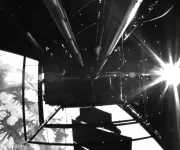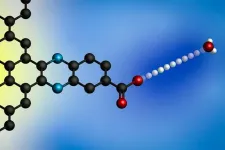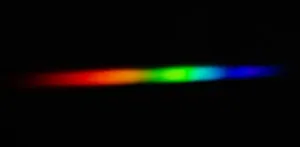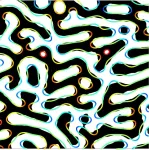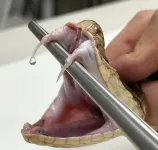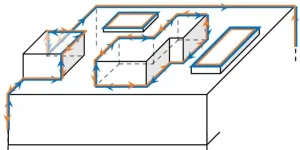One year ago, Caltech’s Space Solar Power Demonstrator (SSPD-1) launched into space to demonstrate and test three technological innovations that are among those necessary to make space solar power a reality.
The spaceborne testbed demonstrated the ability to beam power wirelessly in space; it measured the efficiency, durability, and function of a variety of different types of solar cells in space; and gave a real-world trial of the design of a lightweight deployable structure to deliver and hold the aforementioned solar cells and power transmitters.
Now, with SSPD-1’s mission in space concluded, engineers on Earth are celebrating the testbed’s successes and learning important lessons that will help chart the future of space solar power.
"Solar power beamed from space at commercial rates, lighting the globe, is still a future prospect. But this critical mission demonstrated that it should be an achievable future," says Caltech President Thomas F. Rosenbaum, the Sonja and William Davidow Presidential Chair and professor of physics.
SSPD-1 represents a major milestone in a project that has been underway for more than a decade, garnering international attention as a tangible and high-profile step forward for a technology being pursued by multiple nations. It was launched on January 3, 2023, aboard a Momentus Vigoride spacecraft as part of the Caltech Space Solar Power Project (SSPP), led by professors Harry Atwater, Ali Hajimiri, and Sergio Pellegrino. It consists of three main experiments, each testing a different technology:
DOLCE (Deployable on-Orbit ultraLight Composite Experiment): a structure measuring 1.8 meters by 1.8 meters that demonstrates the novel architecture, packaging scheme, and deployment mechanisms of the scalable modular spacecraft that will eventually make up a kilometer-scale constellation to serve as a power station.
ALBA: a collection of 32 different types of photovoltaic (PV) cells to enable an assessment of the types of cells that can withstand punishing space environments.
MAPLE (Microwave Array for Power-transfer Low-orbit Experiment): an array of flexible, lightweight microwave-power transmitters based on custom integrated circuits with precise timing control to focus power selectively on two different receivers to demonstrate wireless power transmission at distance in space.
"It’s not that we don’t have solar panels in space already. Solar panels are used to power the International Space Station, for example,” says Atwater, Otis Booth Leadership Chair of Division of Engineering and Applied Science; Howard Hughes Professor of Applied Physics and Materials Science; director of the Liquid Sunlight Alliance; and one of the principal investigators of SSPP. “But to launch and deploy large enough arrays to provide meaningful power to Earth, SSPP has to design and create solar power energy transfer systems that are ultra-lightweight, cheap, flexible, and deployable."
DOLCE: Deploying the Structure
Though all of the experiments aboard SSPD-1 were ultimately successful, not everything went according to plan. For the scientists and engineers leading this effort, however, that was exactly the point. The authentic test environment for SSPD-1 provided an opportunity to evaluate each of the components and the insights gleaned will have a profound impact on future space solar power array designs.
For example, during the deployment of DOLCE—which was intended to be a three- to four-day process—one of the wires connecting the diagonal booms to the corners of the structure, which allowed it to unfurl, became snagged. This stalled the deployment and damaged the connection between one of the booms and the structure.
With the clock ticking, the team used cameras on DOLCE as well as a full-scale working model of DOLCE in Pellegrino's lab to identify and try to solve the problem. They established that the damaged system would deploy better when warmed directly by the Sun and also by solar energy reflected off Earth.
Once the diagonal booms had been deployed and the structure was fully uncoiled, a new complication arose: Part of the structure became jammed under the deployment mechanism, something that had never been seen in laboratory testing. Using images from the DOLCE cameras, the team was able to reproduce this kind of jamming in the lab and developed a strategy to fix it. Ultimately, Pellegrino and his team completed the deployment through a motion of DOLCE's actuators that vibrated the whole structure and worked the jam free. Lessons from the experience, Pellegrino says, will inform the next deployment mechanism.
"The space test has demonstrated the robustness of the basic concept, which has allowed us to achieve a successful deployment in spite of two anomalies," says Pellegrino, Joyce and Kent Kresa Professor of Aerospace and Civil Engineering and co-director of SSPP. "The troubleshooting process has given us many new insights and has sharply focused us on the connection between our modular structure and the diagonal booms. We have developed new ways to counter the effects of self-weight in ultralight deployable structures."
ALBA: Harvesting Solar Energy
Meanwhile, the photovoltaic performance of three entirely new classes of ultralight research-grade solar cells, none of which had ever been tested in orbit before, were measured over the course of more than 240 days of operation by the ALBA team, led by Atwater. Some of the solar cells were custom-fabricated using facilities in the SSPP labs and the Kavli Nanoscience Institute (KNI) at Caltech, which gave the team a reliable and fast way to get small cutting-edge devices quickly ready for flight. In future work, the team plans to test large-area cells made using highly scalable inexpensive manufacturing methods that can dramatically reduce both the mass and the cost of these space solar cells.
Space solar cells presently available commercially are typically 100 times more expensive than the solar cells and modules widely deployed on Earth. This is because their manufacture employs an expensive step called epitaxial growth, in which crystalline films are grown in a specific orientation on a substrate. The SSPP solar cell team achieved low-cost nonepitaxial space cells by using cheap and scalable production processes like those used to make today's silicon solar cells. These processes employ high-performance compound semiconductor materials such as gallium arsenide that are typically used to make high-efficiency space cells today.
The team also tested perovskite cells, which have captured the attention of solar manufacturers because they are cheap and flexible, and luminescent solar concentrators with the potential to be deployed in large flexible polymer sheets.
Over ALBA's lifespan, the team collected enough data to be able to observe changes in the operation of individual cells in response to space weather events like solar flares and geomagnetic activity. They found, for example, tremendous variability in the performance of the perovskite cells, whereas the low-cost gallium arsenide cells consistently performed well overall.
"SSPP gave us a unique opportunity to take solar cells directly from the lab at Caltech into orbit, accelerating the in-space testing that would normally have taken years to be done. This kind of approach has dramatically shortened the innovation-cycle time for space solar technology," says Atwater.
MAPLE: Wireless Power Transfer in Space
Finally, as announced in June, MAPLE demonstrated its ability to transmit power wirelessly in space and to direct a beam to Earth—a first in the field. MAPLE experiments continued for eight months after the initial demonstrations, and in this subsequent work, the team pushed MAPLE to its limits to expose and understand its potential weaknesses so that lessons learned could be applied to future design.
The team compared the performance of the array early in the mission with its performance at the end of the mission, when MAPLE was intentionally stressed. A drop in the total transmitted power was observed. Back in the lab on Earth, the group reproduced the power drop, attributing it to the degradation of a few individual transmitting elements in the array as well as some complex electrical–thermal interactions in the system.
"These observations have already led to revisions in the design of various elements of MAPLE to maximize its performance over extended periods of time," says Hajimiri, Bren Professor of Electrical Engineering and Medical Engineering and co-director of SSPP. "Testing in space with SSPD-1 has given us more visibility into our blind spots and more confidence in our abilities."
SSPP: Moving Forward
SSPP began after philanthropist Donald Bren, chairman of Irvine Company and a life member of the Caltech community, first learned about the potential for space-based solar energy manufacturing as a young man in an article in Popular Science magazine. Intrigued by the potential for space solar power, Bren approached Caltech's then-president Jean-Lou Chameau in 2011 to discuss the creation of a space-based solar power research project. In the years to follow, Bren and his wife, Brigitte Bren, a Caltech trustee, agreed to make a series of donations (yielding a total commitment of over $100 million) through the Donald Bren Foundation to fund the project and to endow a number of Caltech professorships.
"The hard work and dedication of the brilliant scientists at Caltech have advanced our dream of providing the world with abundant, reliable, and affordable power for the benefit of all humankind," Donald Bren says.
In addition to the support received from the Brens, Northrop Grumman Corporation provided Caltech with $12.5 million between 2014 and 2017 through a sponsored research agreement that aided technology development and advanced the project’s science.
With SSPD-1 winding down its mission, the testbed stopped communications with Earth on November 11. The Vigoride-5 vehicle that hosted SSPD-1 will remain in orbit to support continued testing and demonstration of the vehicle's Microwave Electrothermal Thruster engines that use distilled water as a propellant. It will ultimately deorbit and disintegrate in Earth's atmosphere.
Meanwhile, the SSPP team continues work in the lab, studying the feedback from SSPD-1 to identify the next set of fundamental research challenges for the project to tackle.
END
